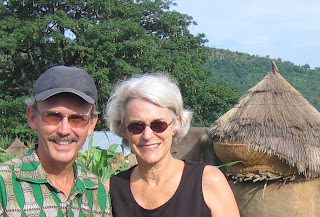Picture five local village troupes of stilt dancers competing for the most outlandish, crowd-pleasing choreography set to traditional music in a stadium full of 3000 people. Visualize acrobatic feats on 12 foot stilts. Imagine a 4 year old shinning up a stilt to be pulled up on the shoulders of a stilt dancer. Conjure up “otherworldly” costumes and frightening masks that keep the dancers safe from evil spells. Create in your mind a flowing gold, gigantic, gilded creature with very long arms and legs. Now you have a picture of the Stilt Dancing Festival.
Friday was a great day for a Peace Corps cross-cultural experience in Atakpamé. KAGBEMA, an organization that we work with, held their 2nd annual Stilt Festival here (called Tchébé in the local language of Ife). Stilt dancing is unique to the Atakpamé area in Togo. The cultural tradition is being revived by this festival. A French stilt artist was here to make it an international affair with his graceful, gold creature. (It turns out shepherds traditionally used stilts in France to keep track of their sheep, but he is a contemporary very artistic stilt dancer.) To top it off, the new US ambassador to Togo and his wife to take in the culture and visit with Peace Corps volunteers after the event.
Hope you enjoy the photos and can view the short videos.
Wayne & Cate




No comments:
Post a Comment